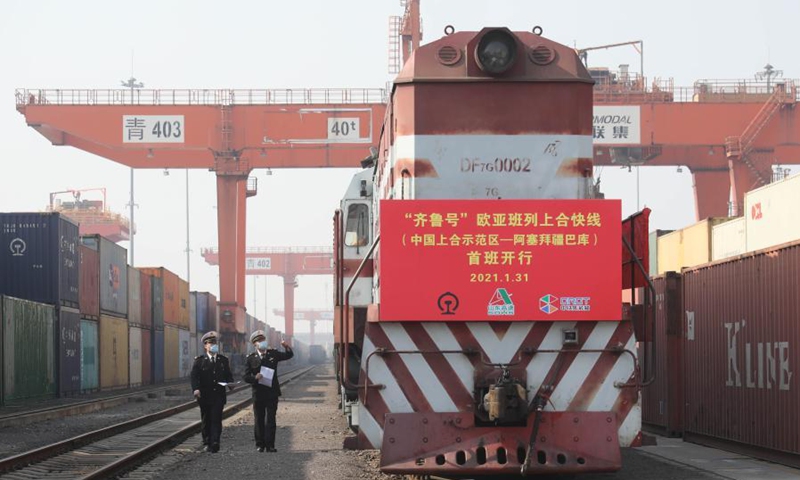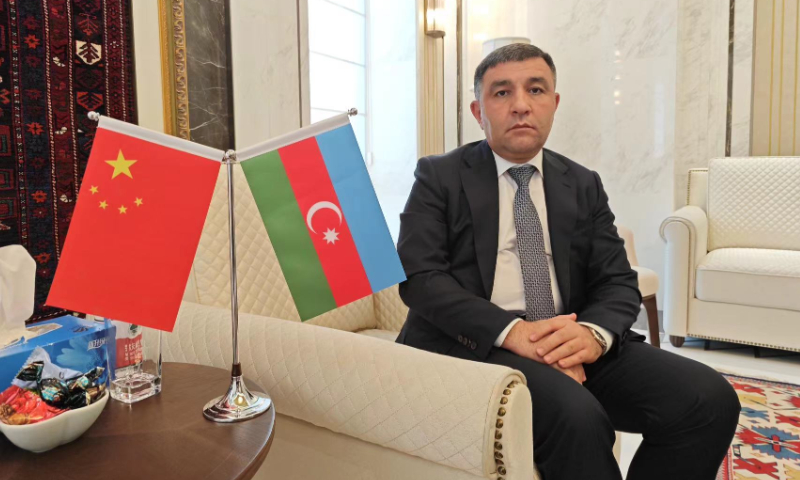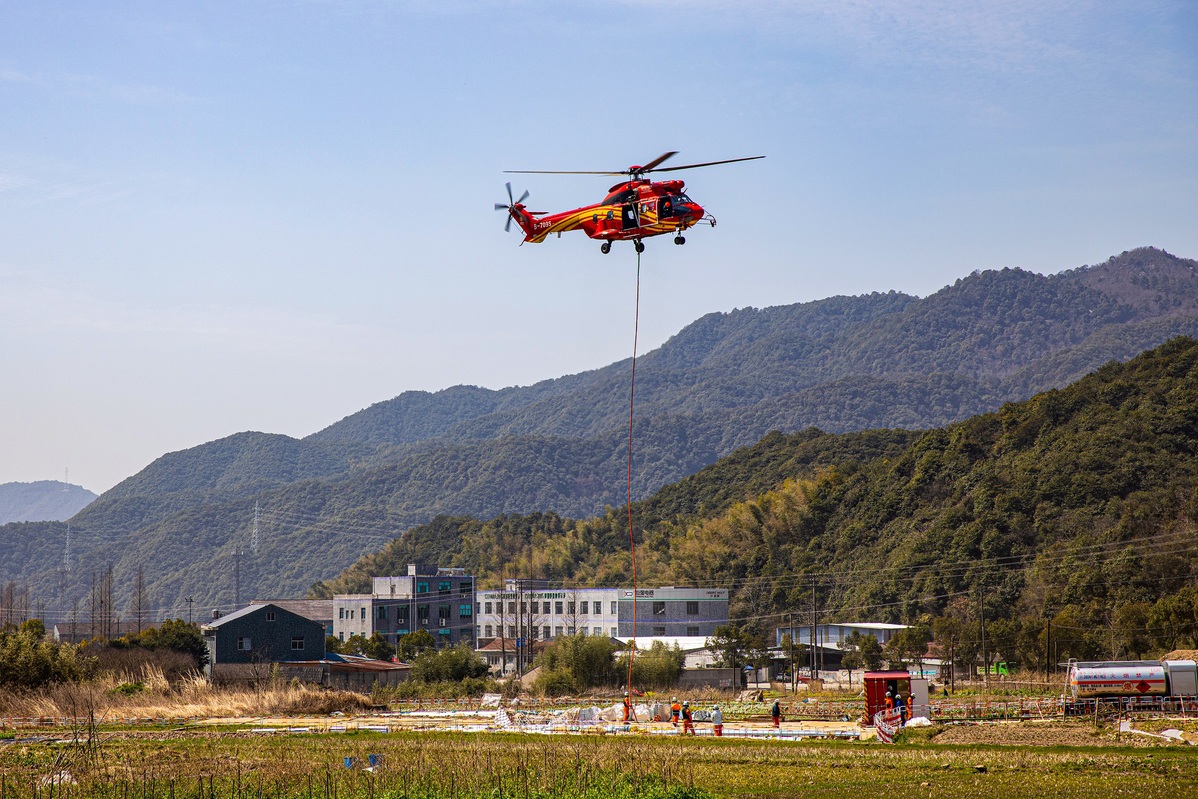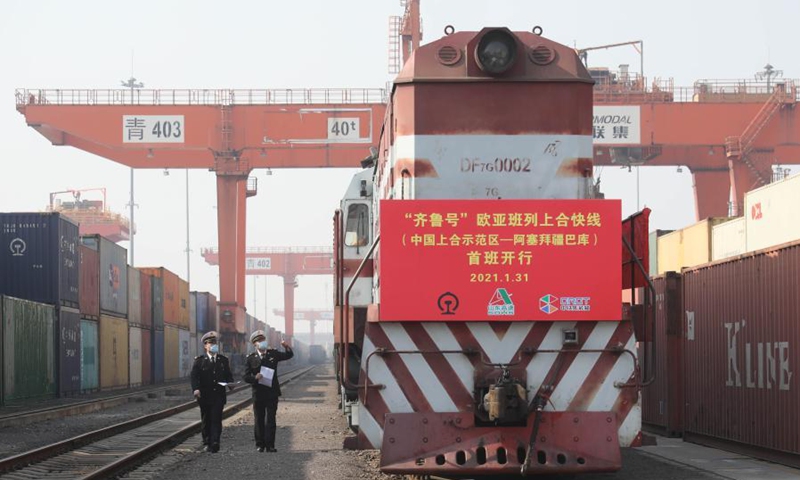
Customs staff members check the first “Qilu” freight train running from Jiaozhou, east China’s Shandong province to Baku, capital of Azerbaijan in Jiaozhou, Jan. 31, 2021. A freight train carrying 100 twenty-foot equivalent unit (TEU) containers’ goods such as tires and air conditions left Jiaozhou on Sunday, marking the launch of “Qilu” freight train services from Jiaozhou to Baku. (Photo by Xie Hao/Xinhua)
Azerbaijan is fully ready to develop economic and trade relations with China without setting any ceiling or limit in terms of scope, Ambassador of Azerbaijan to China Bunyad Huseynov said in an exclusive interview with the Global Times, giving examples of the potential for deeper cooperation in the new-energy industry, where the two countries are highly complementary.
As the world is at a crucial moment in the transition to green energy, the ambassador hopes to deepen cooperation with Chinese companies to achieve sustainable development and win-win outcomes.
Speaking at an investment promotion event held by the Embassy of Azerbaijan in China earlier this week, Huseynov said that China’s remarkable achievements in the field of new energy are well known, and highly complementary cooperation is already well underway.
Recently, Azerbaijan initiated a bidding process to build a new-energy vehicle (NEV) factory. Chinese automaker BYD won the bid and signed an agreement to establish a joint venture company and set up an electric bus production line in Azerbaijan, the ambassador said.
The country is planning to gradually replace fuel buses with electric ones in Baku, the capital of Azerbaijan, Huseynov said, indicating possible cooperation.
“We are also in communication with Contemporary Amperex Technology – a Chinese lithium-ion battery company – regarding the construction of energy storage projects in Azerbaijan,” the envoy said.
The Embassy of Azerbaijan in China is also actively promoting the green transformation and strengthening cooperation with Chinese companies in this field, including replacing the embassy’s fuel vehicles with BYD’s NEVs, the Global Times learned from the embassy.
Chinese companies are also involved in the green energy transition as investors, builders and operators, including in the photovoltaic power sector, according to the embassy.
Closer cooperation in the green field can be foreseen as both countries are playing an increasingly important role in tackling climate change on the world stage.
This November, Azerbaijan will host the 29th session of the Conference of the Parties to the United Nations Framework Convention on Climate Change (COP29) in Baku.
In March, Azerbaijani Minister of Ecology and Natural Resources and president-designate of the COP29 Mukhtar Babayev visited China along with a delegation. This was the first visit of the country’s COP team abroad, to understand China’s expectations from the climate change conference.
“I believe that both countries share a high degree of consensus on the green agenda,” Huseynov said.

Ambassador of Azerbaijan to China Bunyad Huseynov Photo: Yin Yeping/GT
China takes the lead in wind energy and solar, as well as electric vehicles, and is willing to share its achievements with other countries, which the ambassador said “demonstrates China’s open and win-win cooperation attitude.”
Azerbaijan hopes to play a role as a regional growth hub, and cooperating with the booming Chinese new-energy industry can help it achieve its own transformation, Chinese experts said.
“Azerbaijan does not want to remain solely in the fields of fossil energy and raw materials. It hopes to make achievements in the new manufacturing industry, and strengthening cooperation with Chinese companies in the field is a natural option to reach that goal,” Zhang Hong, a senior research fellow at the Institute of Russian, Eastern European and Central Asian Studies of the Chinese Academy of Social Sciences, told the Global Times on Thursday.
Deepening cooperation with Chinese enterprises can help Azerbaijan achieve its energy transformation faster and enhance its industrial innovation capabilities, meeting its needs for industrial modernization and development, Zhang said.
Azerbaijan is not alone. Countries such as Kazakhstan, Uzbekistan and Russia are also actively attracting Chinese NEV companies to invest in building factories in a bid to drive the development of their own NEV industry chains.
The positive moves of these regional countries are in stark contrast with the intensified protectionist actions taken by the US, experts said.
Asked for comments on the “overcapacity” narrative in new energy by some Western media outlets, the Azerbaijani ambassador said that China not only produces high-quality and affordable products but is also willing to share these achievements with the world.
“The world is at a crucial moment in the transition to green energy, and Chinese companies are collaborating with those from other countries with an open attitude to help them achieve this energy transformation,” Huseynov said, noting that “this initiative is worthy of praise.”
“Regardless of how certain media outlets may perceive it, I greatly appreciate China’s open and cooperative attitude,” Huseynov said
On a separate note, the ambassador highly commended the China-proposed Belt and Road Initiative, in which Azerbaijan has been one of the earliest and most active respondents and participants.
“The value of this global cooperation initiative lies in ‘building bridges rather than walls’,” Huseynov said, noting that this joint initiative “serves as a demonstration of the spirit of cooperation and openness, which is needed for global development at the current stage.”
 A helicopter carries construction materials to a designated site in Ningbo, Zhejiang province, April 16, 2024. [Photo provided to chinadaily.com.cn]
A helicopter carries construction materials to a designated site in Ningbo, Zhejiang province, April 16, 2024. [Photo provided to chinadaily.com.cn] 




